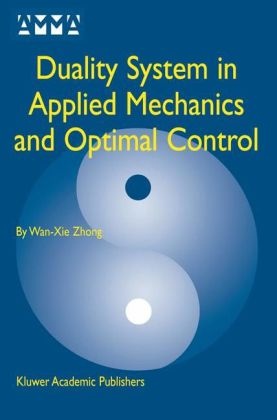Mehr lesen
A unified approach is proposed for applied mechanics and optimal control theory. The Hamilton system methodology in analytical mechanics is used for eigenvalue problems, vibration theory, gyroscopic systems, structural mechanics, wave-guide, LQ control, Kalman filter, robust control etc. All aspects are described in the same unified methodology. Numerical methods for all these problems are provided and given in meta-language, which can be implemented easily on the computer. Precise integration methods both for initial value problems and for two-point boundary value problems are proposed, which result in the numerical solutions of computer precision.
Key Features of the text include:
-Unified approach based on Hamilton duality system theory and symplectic mathematics. -Gyroscopic system vibration, eigenvalue problems.
-Canonical transformation applied to non-linear systems.
-Pseudo-excitation method for structural random vibrations.
-Precise integration of two-point boundary value problems.
-Wave propagation along wave-guides, scattering.
-Precise solution of Riccati differential equations.
-Kalman filtering.
-HINFINITY theory of control and filter.
Inhaltsverzeichnis
Contents Preface
Introduction
0.1. Introduction to Precise integration method
1: Introduction to analytical dynamics
1.1. Holonomic and nonholonomic constraints
1.2. Generalized displacement, degrees of freedom and virtual displacement
1.3. Principle of virtual displacement and the D Alembert principle
1.4. Lagrange equation
1.5. Hamilton variational principle
1.6. Hamiltonian canonical equations
1.7. Canonical transformation
1.8. Symplectic description of the canonical transformation
1.9. Poisson bracket
1.10. Action
1.11. Hamilton-Jacobi equation
2: Vibration theory
2.1. Single degree of freedom vibration
2.2. Vibration of multi-degrees of freedom system
2.3. Small vibration of gyroscopic systems
2.4. Non-linear vibration of multi-degrees of freedom system
2.5. Discussion on the stability of gyroscopic system
3: Probability and stochastic process
3.1. Preliminary of probability theory
3.2. Preliminary of stochastic process
3.3. Quadratic moment stochastic process (regular process)
3.4. Normal stochastic process
3.5. Markoff process
3.6. Spectral density of stationary stochastic process
4: Random vibration of structures
4.1. Models of random excitation
4.2. Response of structures under stationary excitations
4.3. Response under excitation of non-stationary stochastic process
5: Elastic system with single continuous coordinate
5.1. Fundamental equations of Timoshenco beam theory
5.2. Potential energy density and mixed energy density
5.3. Separation of variables, Adjoint symplectic ortho-normality 5.4. Multiple eigenvalues and the Jordan normal form
5.5. Expansion solution of the inhomogeneous equation
5.6. Two end boundary conditions
5.7. Interval mixed energy and precise integration method
5.8. Eigenvector based solution of Riccati equations
5.9. Stepwise integrationmethod by means of sub-structural combination
5.10. Influence function of single continuous coordinate system
5.11. Power flow
5.12. Wave scattering analysis
5.13. Wave induced resonance
5.14. Wave propagation along periodical structures
6: Linear optimal control, theory and computation
6.1. State space of linear system
6.2. Theory of stability
6.3. Prediction, filtering and smoothing
6.4. Prediction and its computation
6.5. Kalman filter
6.6. Optimal smoothing and computations
6.7. Optimal control
6.8. Robust control
Concluding remarks
Zusammenfassung
A unified approach is proposed for applied mechanics and optimal control theory. The Hamilton system methodology in analytical mechanics is used for eigenvalue problems, vibration theory, gyroscopic systems, structural mechanics, wave-guide, LQ control, Kalman filter, robust control etc. All aspects are described in the same unified methodology. Numerical methods for all these problems are provided and given in meta-language, which can be implemented easily on the computer. Precise integration methods both for initial value problems and for two-point boundary value problems are proposed, which result in the numerical solutions of computer precision.
Key Features of the text include:
-Unified approach based on Hamilton duality system theory and symplectic mathematics. -Gyroscopic system vibration, eigenvalue problems.
-Canonical transformation applied to non-linear systems.
-Pseudo-excitation method for structural random vibrations.
-Precise integration of two-point boundary value problems.
-Wave propagation along wave-guides, scattering.
-Precise solution of Riccati differential equations.
-Kalman filtering.
-HINFINITY theory of control and filter.
Zusatztext
From the reviews of the first edition:
"It is one of the purposes of this book, to ease the studying of applied mechanics. … The book can be used not only in the research or teaching of applied mechanics and optimal control theory, but also as a reference book for practical engineering." (Mihail Megan, Zentralblatt MATH, Vol. 1078, 2006)
Bericht
From the reviews of the first edition:
"It is one of the purposes of this book, to ease the studying of applied mechanics. The book can be used not only in the research or teaching of applied mechanics and optimal control theory, but also as a reference book for practical engineering." (Mihail Megan, Zentralblatt MATH, Vol. 1078, 2006)

